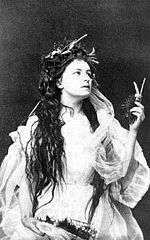Helena Modjeska
| Helena Modjeska | |
|---|---|
|
| |
| Born |
Jadwiga Benda (baptized Helena Opid) 12 October 1840 Free City of Kraków |
| Died |
8 April 1909 (aged 68) Newport Beach, California |
| Spouse(s) |
Gustav Modrzejewski (m.1861-1868; divorced) Count Karol Bozenta Chłapowski (m.1868; divorced) |
| Signature | |
|
| |
Helena Modjeska (October 12, 1840 – April 8, 1909), whose actual Polish surname was Modrzejewska (Polish pronunciation: [mɔdʐɛˈjɛfska], was a renowned actress who specialized in Shakespearean and tragic roles.
Early life
Helena Modjeska was born in Kraków, Poland, on October 12, 1840.[1][2] Her name was recorded at birth as Jadwiga Benda, but she was later baptized Helena Opid, being given her godfather’s surname.[1]
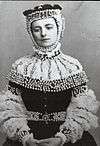
The question of her origins is a complicated one. Modjeska’s mother was Józefa (Misel) Benda, the widow of a prosperous Kraków merchant, Szymon Benda.[3] In her autobiography, Modjeska claimed that her father was a musician named Michael Opid.[4] While it is true that the Benda family did employ a music teacher named Michal Opid, who later stood as Helena’s godfather, Opid was not the father of Józefa Benda’s two youngest children.[3]
There is evidence to suggest that Helena and her older brother Adolf were the results of an affair between Józefa and Prince Władysław Sanguszko, a wealthy and influential Polish nobleman.[1][3]
Also glossed over in Modjeska's autobiography were the details concerning her first marriage, to her former guardian, Gustave Sinnmayer (known in Poland as Gustaw Zimajer). Gustave was an actor and the director of a second-rate provincial theater troupe.[5] The date of Modjeska’s marriage to Gustave is uncertain. She discovered many years later that they had never been legally married, as he was still married to his first wife when they wed.[6] Together the couple had two children, a son Rudolf (later renamed Ralph Modjeski), and a daughter Marylka, who died in infancy.[7]
Gustaw Zimajer used the stage name "Gustaw Modrzejewski."[8] It was the feminine version of this name that Modjeska adopted when she made her stage debut in 1861 as Helena Modrzejewska.[9] Later, when acting abroad, she used a simplified version of her name ("Modjeska"), which was easier for English-speaking audiences to pronounce.[10]

In her early Polish acting career, Modrzejewska played at Bochnia, Nowy Sącz, Przemyśl, Rzeszów and Brzeżany. In 1862 she appeared for the first time in Lwów, playing in her first Romantic drama, as "Skierka" in Juliusz Słowacki's Balladyna. From 1863 she appeared at Stanisławów and Czerniowce, in plays by Słowacki.
In 1865 Zimajer tried to get her a contract with Viennese theaters, but the plan came to naught due to her poor knowledge of the German language. Later that year Helena left Zimajer, taking their son Rudolf, and returning to Kraków.[11] Once there she accepted a four-year theatrical engagement. In 1868 she began appearing in Warsaw; during her eight years there, she consolidated her status as a theater star. Her brothers Józef and Feliks Benda were also well regarded actors in Poland.
An incident illustrates the circumstances under which Polish society then labored. At one of Modrzejewska's Warsaw performances, seventeen secondary-school pupils presented her with a bouquet of flowers tied with a ribbon in the red-and-white Polish national colors. The pupils were accused by the Russian Imperial authorities of conducting a patriotic demonstration. They were expelled from their school and banned from admission to any other school. One of the pupils, Ignacy Neufeld, subsequently shot himself; Modrzejewska attended his funeral.[12]
Chłapowski
On September 12, 1868, Modjeska married a Polish nobleman, Karol Bożenta Chłapowski.[1][13] Best known in America as "Count Bozenta," he was not a count. His family belonged to the untitled landed gentry (szlachta). In the United States he adopted the stage name "Count Bozenta" as a ploy to gain publicity. "Bozenta" was easier for an English-speaking audience to pronounce than "Chłapowski."[14]
At the time of their marriage, Chłapowski was employed as the editor of a liberal nationalist newspaper, Kraj (The Country), which was owned by Adam Sapieha and a Mr. Sammelson.[15] Modjeska wrote that their home "became the center of the artistic and literary world [of Kraków]." Poets, authors, politicians, artists, composers and other actors frequented Modjeska’s salon.[15]
Emigration
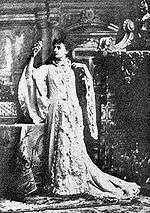
In July 1876, after spending more than a decade as the reigning diva of the Polish national theater, for reasons both personal and political, Modjeska and her husband chose to emigrate to the United States.[16]
My husband's only desire was to take me away from my surroundings and give me perfect rest from my work...Our friends used to talk about the new country, the new life, new scenery, and the possibility of settling down somewhere in the land of freedom, away from the daily vexations to which each Pole was exposed in Russian or Prussian Poland. Henryk Sienkiewicz was the first to advocate emigration. Little by little others followed him, and soon five of them expressed the desire to seek adventures in the jungles of the virgin land.My husband, seeing the eagerness of the young men, conceived the idea of forming a colony in California on the model of the Brook Farm. The project was received with acclamation.[17]
Once in America, Modjeska and her husband purchased a ranch near Anaheim, California. Julian Sypniewski, Łucjan Paprowski, and Henryk Sienkiewicz (winner of the Nobel Prize for literature in 1905), were among the friends who had accompanied them to California. It was during this period that Sienkiewicz wrote his Charcoal Sketches (Szkice węglem). Originally the artists Stanisław Witkiewicz (father of Stanisław Ignacy Witkiewicz) and Adam Chmielowski (the future St. Albert) were also to have come with Modjeska's group, but they changed their plans.
Modjeska intended to abandon her career and envisioned herself living "a life of toil under the blue skies of California, among the hills, riding on horseback with a gun over my shoulder."[17] The reality proved less cinematic. None of the colonists knew the first thing about ranching or farming, and they could barely speak English.[18] The utopian experiment failed, the colonists went their separate ways, and Modjeska returned to the stage, reprising the Shakespearean roles that she had performed in Poland.[1][19] Perhaps the best account of daily life on the ranch is Theodore Payne's memoir, Life on the Modjeska Ranch in the Gay Nineties.
American career
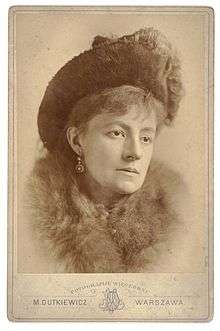
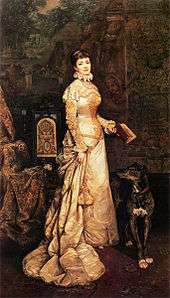
On August 20, 1877 Modjeska debuted at the California Theatre in San Francisco in an English version of Ernest Legouvé's Adrienne Lecouvreur. She was seen by theatrical agent Harry J. Sargent who signed her for a tour on the east coast where she made her New York debut.[20] [21] She then spent three years abroad (1879–82), mainly in London, attempting to improve her English, before returning to the stage in America.[22] Despite her accent and imperfect command of English, she achieved great success.[23]
During her career she played nine Shakespearean heroines, Marguerite Gautier in Camille, and Schiller's Maria Stuart. In 1883, the year she obtained American citizenship, she produced Henrik Ibsen's A Doll's House in Louisville, Kentucky, the first Ibsen play staged in the United States. In the 1880s and 1890s she had a reputation as the leading female interpreter of Shakespeare on the American stage.[24]
In 1893 Modjeska was invited to speak to a women's conference at the Chicago World's Fair, and described the situation of Polish women in the Russian and Prussian-ruled parts of dismembered Poland. This led to a Tsarist ban on her traveling in Russian territory.[25]
Modjeska suffered a stroke and was partially paralyzed in 1897, but recovered and soon returned to the stage, continuing to perform for several additional years.[26]
During her last stay in Poland, from October 31, 1902 to April 28, 1903, she appeared on the stage in Lwów, Poznań and her native Kraków.
On May 2, 1905, she gave a jubilee performance in New York City. Then she toured for two years and ended her acting career, afterward only appearing sporadically in support of charitable causes.
Modjeska died at Newport Beach, California on April 8, 1909, aged 68, from Bright's disease.[27] Her remains were sent to Kraków to be buried in the family plot at the Rakowicki Cemetery.
Her autobiography, Memories and Impressions of Helena Modjeska, was published posthumously in 1910. A Polish translation ran that same year in the Kraków newspaper, Czas (Time). The last Polish edition of the book appeared in 1957.
Modrzejewska's son, Rudolf Modrzejewski (Ralph Modjeski), was a civil engineer who gained fame as a designer of bridges.[28][29]
Legacies
Modjeska's home from 1888 to 1906, "Arden", is a registered National Historic Landmark.
Named for her are:
- Modjeska Park, in Anaheim, California (33°48'53"N 117°57'8"W)
- Modjeska Canyon, California (where Arden is located)
- Modjeska Falls, California, at the Glen Alpine Springs Resort
- Modjeska Peak (the north peak of Saddleback Mountain).
- Bouquet Helena Modjeska by American perfumer John Blocki of Prussian and Polish descent
- Modjeskas, a caramel-covered marshmallow confection invented in 1889 by a local candy-maker named Anton Busath (and later made by other candy-makers, including Bauer's Candies, Muth's Candies and Schimpff's Confectionery) in her honor when she visited Louisville, Kentucky.
- A street in Wrocław, which was formerly named after the German actress Agnes Sorma when the city was part of Germany as Breslau.
- Modjeska Theatre, in Milwaukee Wisconsin
- SS Helena Modjeska, a 7,000 ton US cargo steamer that ran aground on Goodwin Sands in 1946.[31]
Also a statue of Modjeska is located outside the Pearson Park Amphitheater in Anaheim, California.
Modjeska was the mother of bridge engineer Ralph Modjeski and godmother to artist-author-philosopher Stanisław Ignacy Witkiewicz (son of artist Stanisław Witkiewicz, who almost accompanied Modjeska and her family to California in 1876). She was also the aunt of artist Władysław T. Benda.
She was godmother to American actress Ethel Barrymore.
Roles

Modjeska's chief tragic roles were:
- Ophelia, in Hamlet;
- Juliet, in Romeo and Juliet;
- Desdemona, in Othello; and
- Queen Anne, in Richard III.
- Nora, in Henrik Ibsen's A Doll's House.
- Louisa Miller.
- Friedrich Schiller's Maria Stuart and Princess Eboli.
- Marion Delorme, in Victor Hugo's Marion Delorme.
- Victor Hugo's Tisbé.
- Juliusz Słowacki's Maria Stuart and Mazeppa.
Modrzejewska was also the Polish interpreter of the most prominent plays by Ernest Legouvé, Alexandre Dumas, père and fils, Émile Augier, Alfred de Musset, Octave Feuillet and Victorien Sardou.
In literature
Susan Sontag's award-winning 1999 novel, In America, though fiction, is based on Modjeska's life.[32] The book precipitated a controversy when Sontag was accused of having plagiarized other works about Modjeska.[33]
Modjeska was a character in the novella My Mortal Enemy, by Willa Cather.
Scholars Joanna and Catharina Polatynska have posited that Modjeska might have been Arthur Conan Doyle's model for the character Irene Adler, the only woman that Sherlock Holmes came close to loving. In "A Scandal in Bohemia", Doyle mentions Adler having been prima donna of the fictional Imperial Opera of Warsaw in the same years when Modjeska was at the peak of her theatrical career in Warsaw, and the fictional character's personality recalls that of the actual actress.[34]
Death anniversary
In 2009, in honor of the 100th anniversary of her death, the Historical Museum of the City of Kraków presented an exhibition, "Helena Modjeska (1840-1909): For the Love of Art" (8 April – 20 September 2009). The Warsaw staging of the same exhibition ran from October 2009 through January 2010.[35] The exhibition included items from the Bowers Museum in Santa Ana, California.
See also
Notes
- 1 2 3 4 5 Shattuck, Shakespeare on the American Stage, p. 126.
- ↑ Modjeska, Memories and Impressions, p. 15.
- 1 2 3 Coleman, Fair Rosalind, p. 1.
- ↑ Modjeska, Memories and Impressions, page 17.
- ↑ Osnes, Acting.
- ↑ Shattuck, Shakespeare on the American Stage, pp. 126 and 317.
- ↑ Modjeska, Memories and Impressions, p. 114.
- ↑ The surname "Modrzejewski" would seem to derive from "modrzew," the Polish for "larch."
- ↑ Wilmeth, Cambridge Guide to American Theatre, p. 263.
- ↑ Encyclopedia - Britannica Online Encyclopedia at www.britannica.com
- ↑ "Helena Modjeska," Encyclopædia Britannica, 2009. Encyclopædia Britannica Online. Accessed 19 Feb 2009. http://www.britannica.com/EBchecked/topic/387379/Helena-Modjeska
- ↑ Information from the Polish Wikipedia article, edition of 19:53, 25 January 2009.
- ↑ Modjeska, Memories and Impressions, p. 154.
- ↑ Modjeska, Memories and Impressions, p. 346.
- 1 2 Modjeska, Memories and Impressions, p. 174.
- ↑ Modjeska, Memories and Impressions, p. 257.
- 1 2 Modjeska, Memories and Impressions, p. 249.
- ↑ Modjeska, Memories and Impressions, p. 250.
- ↑ Obst, "Ralph Modjeski—Bridge Builder" http://info-poland.buffalo.edu/exhib/modjeski/modj.html.
- ↑ HELENA, HELENA (1910). MEMORIES AND IMPRESSIONS OF HELENA MODJESKA. THE MACMILLAN COMPANY. p. 336. Retrieved August 30, 2016.
- ↑ San Francisco Chronicle (Oct.17, 2010) "Modjeska--Woman Triuimphant"
- ↑ Shattuck, Shakespeare on the American Stage, p. 128.
- ↑ "Modjeska, Helena," Encyclopedia Americana, 1986 ed., vol. 19, p. 313.
- ↑ Shattuck, Shakespeare on the American Stage, p. 127.
- ↑ Modjeska, Memories and Impressions, p. 518.
- ↑ Gerald Boardman and Thomas S. Hischak, The Oxford Companion to American Theatre, 2004. http://www.encyclopedia.com/doc/1O149-ModjeskaHelena.html
- ↑ Helena Modjeska--Woman Triumphant, a documentary film
- ↑ Obst, "Ralph Modjeski—Bridge Builder" http://info-poland.buffalo.edu/exhib/modjeski/modj.html
- ↑ Jerzy Jan Lerski et al., Historical Dictionary of Poland, p. 361.
- ↑ Inkersley, Arthur (February 1911). "Modjeska's Life in California". Overland Monthly. LVII (2): 178–185.
- ↑ "SS Helena Modjeska". www.ramsgatehistory.com. Retrieved 2016-11-24.
- ↑ Susan Sontag, In America: A Novel, introduction, New York, 1999.
- ↑ Doreen Carvajal, 27 May 2002. "So Whose Words Are They? Susan Sontag Creates a Stir." New York Times Book Review.
- ↑ Diogenes Club
- ↑ Malgorzata Palka (translator: Piotr Krasnowolski), exhibition notes: Helena Modjeska (1840-1909): For the Love of Art. Muezeum Histoyczne Miasta Krakowa and Teatr Wielki – Polish National Opera in Warsaw.
References
- Gerald Boardman and Thomas S. Hischak, The Oxford Companion to American Theatre, 2004. http://www.encyclopedia.com/doc/1O149-ModjeskaHelena.html
- Marion Moore Coleman, Fair Rosalind: the American Career of Helena Modjeska, Cheshire, Cherry Hill Books, 1969.
- Mabel Collins, The Story of Helena Modjeska, London, 1883.
- Jerzy Got, ed, Korespondencja Heleny Modrzejewskiej i Karola Chłapowskiego (Correspondence of Helena Modrzejewska and Karol Chłapowski), Warsaw, 1965.
- Antoni Gronowicz, Modjeska: Her Life and Loves, New York, 1956.
- Lerski, George J. (Jerzy Jan); Wróbel, Piotr; Kozicizi, Richard J. (1996). Historical Dictionary of Poland, 966-1945. Westport, CT: Greenwood Press – via Questia (subscription required) . ISBN 0-313-26007-9.
- Helena Modjeska, Memories and Impressions, New York, MacMillan, 1910.
- Peter J. Obst, "Ralph Modjeski—Bridge Builder," Polish Academic Information Center, University at Buffalo, 2000. http://info-poland.buffalo.edu/exhib/modjeski/modj.html.
- Beth Osnes, Acting: An Encyclopedia of Traditional Culture, New York, ABC-Clio, 2001.
- Anne Seagraves, Women Who Charmed the West, Post Falls, 1991.
- Charles Harlen Shattuck, Shakespeare on the American Stage, Washington, Associated University Presses, 1987.
- Don B. Wilmeth, Cambridge Guide to American Theatre, Cambridge University Press, 1996.
- Bill Kemp, "Famed actress Modjeska wowed locals," Pantagraph, April 10, 2016, http://www.pantagraph.com/news/local/pfop-famed-actress-modjeska-wowed-locals/article_7374d700-3dc5-5843-9321-437e28d9de8e.html.
External links
Archival collections
- Works by or about Helena Modjeska at Internet Archive
- Guide to the Ellen K. Lee Collection on Helena Modjeska and Orange County. Special Collections and Archives, The UC Irvine Libraries, Irvine, California.
- Guide to the Collection of Helena Modjeska Theater Memorabilia. Special Collections and Archives, The UC Irvine Libraries, Irvine, California.
- Guide to the Helena Modjeska Collection. Special Collections and Archives, The UC Irvine Libraries, Irvine, California.
- Madam Modjeska scrapbooks, 1877-1898, held by the Billy Rose Theatre Division, New York Public Library for the Performing Arts
Other
| Wikiquote has quotations related to: Helena Modjeska |
| Wikimedia Commons has media related to Helena Modrzejewska. |
Helena Modrzejewska at culture.pl
- Modjeska's Full Biography Appears in the U.S.
- Diogenes Club. Theaters in Warsaw, Where Irene Adler Sang
- A play in which Modjeska reflects on her life
- A documentary film about Helena Modjeska's life and passions
-
 Texts on Wikisource:
Texts on Wikisource:
- "Modjeska, Helena". Collier's New Encyclopedia. 1921.
- "Modjeska, Helena". Encyclopedia Americana. 1920.
- "Modjeska, Helena". The New Student's Reference Work. 1914.
- "Modjeska, Helena". Encyclopædia Britannica (11th ed.). 1911.
- "Modjeska, Helena". The Nuttall Encyclopædia. 1907.
- "Modjeska, Helena". New International Encyclopedia. 1905.
- "Modjeska, Helena". Appletons' Cyclopædia of American Biography. 1900.
- Holmgren, Beth. Starring Madame Modjeska: On Tour in Poland and America. Bloomington: Indiana University Press, 2011.
